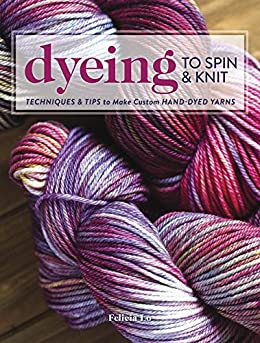Book Review: Dyeing to Spin and Knit by Felicia Lo
reviewed by Sukrita Mahon

With every kind of tutorial and technique easily searchable online, dyeing has never been more accessible to spinners and knitters. Most crafters are likely to experiment with some type of dyeing or colour blending at some point in their practice. The creator of Sweet Georgia Yarns, Felicia Lo, has managed to produce an extremely comprehensive guide to dyeing that proves useful for the novice and experienced dyer alike.
In the early chapters, Lo touches on some fascinating cultural aspects and responses to colour. As a child, she was drawn to bright colours and wanted to wear them often, but her peers thought it strange. It resonates a lot with my own experience in western society, where it seems that dull, muted, or neutral colours are most favoured. It leads to all kinds of complicated feelings about colour, such as which are pleasing together or not or which look good with certain complexions. I find myself suspecting that we project a lot of feelings of inadequacies into our colour senses, especially in the west. It’s a shame, when they’re really meant to bring us joy, and maybe even freedom.
The author’s journey from craving to rejecting colour to rediscovering and exploring it in depth is very compelling. The idea that we need colour in our lives in some fundamental way stands out to me. We naturally have emotional reactions to colour, and particularly as crafters, we have the ability to explore them in such a way that can end up feeling therapeutic. Many of us can resonate with that feeling of awe when working with a special colourway. For those who are perhaps wary of starting to experiment on their own, there is an excellent chapter on colour theory that provides a basis for how colours interact and are perceived.
The sections on dyeing are very thorough, with instructions on setting up a dye studio as well. A lot of small-scale dyeing can be done in the kitchen, but when using acid dyes, it is advisable to have a separate area if possible. I found a lot of invaluable tips in this section, like choosing heavier bottomed pans over thin ones to ensure even heating. Lo touches on natural dyeing and the richness of colours that can be created with it, providing lots of tantalising photos. In the case of acid dyeing, she explains how to measure dyes to get the same colour, even without the use of a precise scale.
We go on to learn how to dye yarn for all types of different effects: solid colour, tonal, variegated, hand painted, self striping, gradient, resist dyeing, layering. There is enough inspiration in these pages to pique the interest of dyers who may already know these techniques. The part on mistakes and troubleshooting mistakes is much appreciated – I could have used these at several points in my own dyeing journey.
Spinning with colour opens up a whole new world of possibilities, and this was my favourite part of the book. There are so many ideas to explore that it left me buzzing. The beautiful complexity of the yarns created with optical mixing and combination drafting, for example, made me want to pull out some fibre right away. There is plenty of material for non-dyeing spinners to experiment with, such as the ways in which grist, pre-drafting, or staple length can affect colour.
One of the key take-aways from the spinning chapters was the multitude of ways in which fibre can be split and spun to create various effects, like short or long colour repeats, gradients, or muted colour stories. Spinning straight from dyed top can be interesting but doesn’t always result in the most exciting fabric. Batts add another layer of fun and experimentation, despite being time intensive to make. The blending possibilities are greatly increased, so even mixing two colours gently can result in a more complex yarn than other methods. The author teaches us how to make layers of different colours and spin them to different effects.
Lo obviously knows spinners well, because she nudges us to actually knit, crochet, or weave with the yarn instead of calling the process finished once it’s washed. I will, Felicia, just as soon as I’m finished spinning it all…
The book helpfully tries to explain how to best use multicoloured yarn in knitting, and how stitch patterns are affected by the way it’s dyed. It ends with a chapter of knitting patterns designed by the author. Some of these are handspun, and the rest could easily be adapted to work with handspun. They are mostly cowls and shawls, a blanket and a pair of socks.
In my view, almost every dyer or spinner could find some value in this book, even if they’ve been playing with colour for a while. The ideas, inspiration, and photographs alone make it a worthwhile addition to the spinning bookshelf – the author’s passion is quite infectious.
Rating: 4/5
PLY Magazine believes that Black lives matter, as well as LBGTQI+ lives. Those most vulnerable and persecuted in our communities deserve our love and support. Please be good to each other.





Leave a Reply
Want to join the discussion?Feel free to contribute!